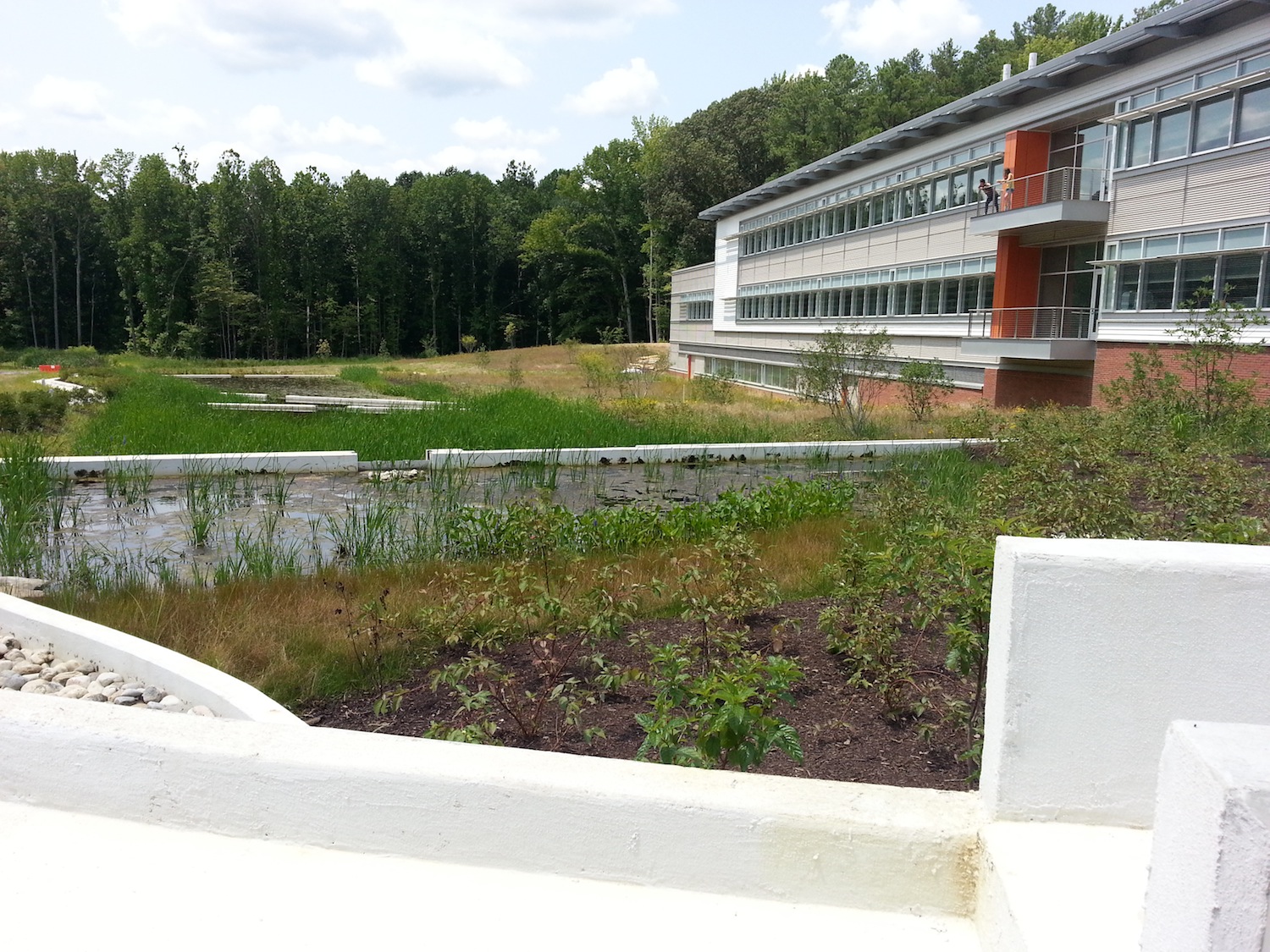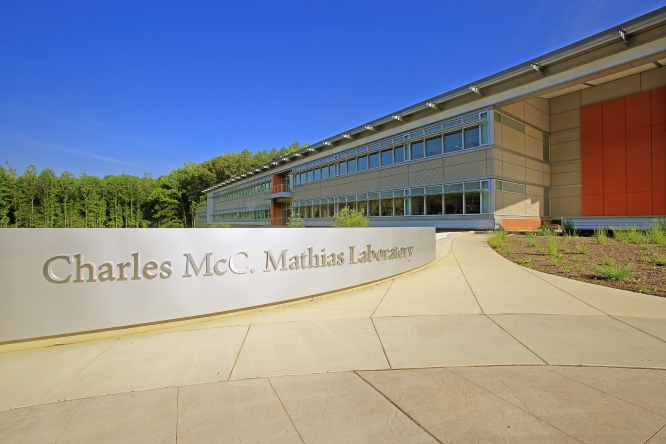The Smithsonian Institution opened the doors of its greenest building to date on Friday, Sept. 19: the Charles McC. Mathias Laboratory on the campus of the Smithsonian Environmental Research Center in Edgewater, Md. Designed to be the first Leadership in Energy and Environmental Design Platinum building in the Institution, the Mathias Lab will emit 37% less CO2 than a comparable lab that does not meet LEED-certification standards.
Before the new Mathias Lab, almost two-thirds of SERC’s office space and one-fourth of its lab space were housed in trailers. The disjointed environment hindered communication and the kind of experiments scientists were able to do.
“The new lab provides us flexible space for future cutting-edge research,” said SERC Director Anson “Tuck” Hines. “Biogenomics, conservation biology, global change—these are all at the forefront of environmental science today. The new lab gives our scientists the ability to explore new territory in a more sustainable way.”
Building a sustainable research laboratory is more difficult than building a sustainable home, office space or school, largely because research environments are highly energy intensive and typically consume three-to-four times as much electricity as other buildings. However, research efforts on climate change, invasive species and conserving the Chesapeake Bay are vital to preserving healthy ecosystems throughout the rest of the world. The challenge for lead architect Howard Skoke of EwingCole was to enhance these research projects while slashing their environmental footprint.

On the south side of the lab, this 4.65-acre constructed wetland acts as rain garden to filter stormwater. The wetland also receives irrigation as part of the lab’s system to recycle 100 percent of its water. Photo: Monaca Noble / Smithsonian Environmental Research Center
The finished lab’s reduced carbon footprint comes from a substantial reliance on renewables. A geothermal well field with 250 wells provides a highly efficient heat exchange for the lab’s HVAC system, while a 352-kilowatt array of solar panels provides water heating and covers 15 percent of the building’s annual electricity expense. Energy efficiency also received a boost from passive solar lighting, a result of its open interior design and large windows, as well as automated lighting controls and strong insulation. In total, the Mathias Lab will save an estimated 42 percent on energy costs each year compared to a lab without LEED certification.
The lab will also recycle 100% of its water through innovative interconnection of systems. All domestic “gray water” will go to a wastewater treatment plant on the SERC campus within walking distance of the lab. From there, it will be sent back to the lab for reuse in fire protection, irrigation and the water-closet supply. Some of the water will nourish the 4.5-acre constructed wetland on the lab’s south side. Three cisterns will capture rainwater to irrigate the wetland, which will filter stormwater and provide a living habitat for native plants and animals.
The majority of the project’s $57 million funding came from Congress. Construction began in May 2011 with the addition of 69,000 sf of new laboratory and office space. Renovation of the existing 23,000-sf laboratory completed the project in fall 2014.
“Mac Mathias would have loved this building as much as the research that is going to go on inside it,” said Sen. Ben Cardin (D-Md.). “This new lab will dramatically advance research efforts on conserving the Chesapeake and understanding climate change. Highly energy efficient, heavily reliant on renewable energy sources and quite beautiful, the lab is a statement on how the built and natural environments can continually complement one another.”
“As a strong supporter of the Smithsonian Environmental Research Center, I’m pleased that this new sustainable research facility will provide men and women at the forefront of environmental science with the space needed to conduct their critical work,” said Congressman Steny Hoyer (D-Md.). “Throughout my career, I’ve been proud to support investments in research and innovation, and I look forward to joining the SERC team as they open the new Mathias Lab.”
EwingCole was the design firm for the project. The general contractor was Hensel Phelps Construction Company.
Related Stories
Retail Centers | Apr 4, 2024
Retail design trends: Consumers are looking for wellness in where they shop
Consumers are making lifestyle choices with wellness in mind, which ignites in them a feeling of purpose and a sense of motivation. That’s the conclusion that the architecture and design firm MG2 draws from a survey of 1,182 U.S. adult consumers the firm conducted last December about retail design and what consumers want in healthier shopping experiences.
Healthcare Facilities | Apr 3, 2024
Foster + Partners, CannonDesign unveil design for Mayo Clinic campus expansion
A redesign of the Mayo Clinic’s downtown campus in Rochester, Minn., centers around two new clinical high-rise buildings. The two nine-story structures will reach a height of 221 feet, with the potential to expand to 420 feet.
Sports and Recreational Facilities | Apr 2, 2024
How university rec centers are evolving to support wellbeing
In a LinkedIn Live, Recreation & Wellbeing’s Sadat Khan and Abby Diehl joined HOK architect Emily Ostertag to discuss the growing trend to design and program rec centers to support mental wellbeing and holistic health.
Architects | Apr 2, 2024
AE Works announces strategic acquisition of WTW Architects
AE Works, an award-winning building design and consulting firm is excited to announce that WTW Architects, a national leader in higher education design, has joined the firm.
Office Buildings | Apr 2, 2024
SOM designs pleated façade for Star River Headquarters for optimal daylighting and views
In Guangzhou, China, Skidmore, Owings & Merrill (SOM) has designed the recently completed Star River Headquarters to minimize embodied carbon, reduce energy consumption, and create a healthy work environment. The 48-story tower is located in the business district on Guangzhou’s Pazhou Island.
K-12 Schools | Apr 1, 2024
High school includes YMCA to share facilities and connect with the broader community
In Omaha, Neb., a public high school and a YMCA come together in one facility, connecting the school with the broader community. The 285,000-sf Westview High School, programmed and designed by the team of Perkins&Will and architect of record BCDM Architects, has its own athletic facilities but shares a pool, weight room, and more with the 30,000-sf YMCA.
Market Data | Apr 1, 2024
Nonresidential construction spending dips 1.0% in February, reaches $1.179 trillion
National nonresidential construction spending declined 1.0% in February, according to an Associated Builders and Contractors analysis of data published today by the U.S. Census Bureau. On a seasonally adjusted annualized basis, nonresidential spending totaled $1.179 trillion.
Affordable Housing | Apr 1, 2024
Biden Administration considers ways to influence local housing regulations
The Biden Administration is considering how to spur more affordable housing construction with strategies to influence reform of local housing regulations.
Affordable Housing | Apr 1, 2024
Chicago voters nix ‘mansion tax’ to fund efforts to reduce homelessness
Chicago voters in March rejected a proposed “mansion tax” that would have funded efforts to reduce homelessness in the city.
Standards | Apr 1, 2024
New technical bulletin covers window opening control devices
A new technical bulletin clarifies the definition of a window opening control device (WOCD) to promote greater understanding of the role of WOCDs and provide an understanding of a WOCD’s function.

















